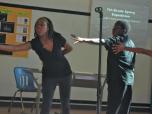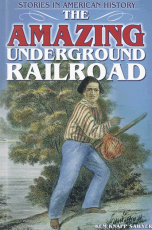Kem Knapp Sawyer
Books for young readers
Blog
At Two Rivers Public Charter School

A year ago I visited a 7th grade class at the Two Rivers Public Charter School to talk about my book Freedom Calls: Journey of a Slave Girl. This past March, Jenese Jones, Erica Marcus, and Alicia Rosenberg, 7th grade teachers at Two Rivers, asked me to return. Their class was planning to interview several people about the question: “If slavery “officially” ended over 100 years ago, why should 7th graders at Two Rivers still care about slavery in 2012?” The 7th graders had spent several months researching and discussing the topic and they had carefully prepared their questions—as part of what the school calls “expeditionary learning.” They were taught to use “expert thinking,” reflection, communication, and collaboration to solve problems.
This week the school is producing “Community Showcase! Spring Expedition 2012”—a presentation by several grades on their expeditionary learning—with topics ranging from physics of flight, to genetics and watershed ecology.
The 7th graders presented “Snapshots in Time”—a play in four acts. In the first act called “Auction Day at the Slave Fort… Let’s Make a Deal,” students re-enacted a slave auction in Africa. The second act, “Paradox of Liberty,” featured Thomas Jefferson—enslavement, the authoring of the Declaration of Independence, his relationship with Sally Hemings—the conflict between thought and deed. The third act, “Separate, But Equal,” brought to life the difficulties many African American children faced during Reconstruction as they struggled to learn to read. And the fourth, “Here and Now,” focused on parallels between the abolition of slavery, the equal rights movement, and the struggle for economic and educational justice.
When the play ended audience members were invited to talk to the performers and to listen to the podcasts they had made based on their expeditionary learning. These included excerpts from their interviews. 7th grader Tai’Leigh McKeithan told me about her trip to the Paradox of Liberty exhibit (focused on Thomas Jefferson) at the Smithsonian Museum of American History, pointing out that the exhibit was next to the lunch counter from the Greensboro Woolworth’s where four African American college students staged a sit-in after they were denied service because of their race. Expeditionary learning helped Tai’Leigh and other students draw parallels and gain a better understanding of the equal rights movement—it has made them think about the Trayvon Martin shooting and Occupy Wall Street in new ways.
In the “Snapshots in Time” finale a student newscaster provides comic relief. This actor does a sensational parody of a reporter who has no time to listen—one who fires off question after question. Those who are interviewed have to finish each other’s sentences as they speak of the many achievements that have been made in the equal rights movement. As I watched his performance I couldn’t help thinking that expeditionary learning encourages students to do just the opposite of this pseudo-newscaster—to listen carefully, to delve deeply, to examine thoroughly, and to solve problems.
I have a copy of the program for “Snapshots in Time” on my desk. On the front cover is a picture of a slave ship that transported hundreds of men, women, and children. They were made to lie side by side on the bare floor, touching one another, with no room to stretch or stand. On the back of the program is a photograph of Frederick Douglass, the leader who left us with one of the robust calls to action of all time: “Let us then, wherever we are, whether at the North or at the South, resolutely struggle on in the belief that there is a better day coming, and that we by patience, industry, uprightness, and economy may hasten that better day. . . . Greatness does not come to any people on flowery beds of ease. We must fight to win the prize.”
